Maastricht 作者: 来源: 发布时间:2021-04-29
一、所属省或是州,具体位置,人口,面积
Mastrique is a city and a municipality in the southeast of the Netherlands. It is the capital and largest city of the province of Limburg. Maastricht is located on both sides of the Meuse (Dutch: Maas), at the point where the Jeker joins it. It is adjacent to the border with Belgium.
The population of Maastricht: 122,397 (2015)
City rights: 1204
Country: Netherlands
Area code: 043
Elevation: 49 m (161 ft)
Coordinates: 50°51′N 5°41′E
Location in Limburg
Coordinates: 50°51′N 5°41′ECoordinates: 50°51′N 5°41′E
Country Netherlands
Province Limburg Limburg
City Hall Maastricht City Hall
Boroughs 5 districts
Area
• Municipality 60.03 km2 (23.18 sq mi)
• Land 56.81 km2 (21.93 sq mi)
• Water 3.22 km2 (1.24 sq mi)
Elevation 49 m (161 ft)
Population (Municipality, January 2019; Urban and Metro, May 2014)
• Municipality 121,565
• Density 2,140/km2 (5,500/sq mi)
•Urban 277,721
Urban population for Dutch-Belgian region; metropolitan population for Dutch-Belgian-German region.
Demonyms (Dutch) Maastrichtenaar;
(Limb.) Mestreechteneer or "Sjeng" (nickname)
Time zone UTC+1 (CET)
• Summer (DST) UTC+2 (CEST)
Postcode
6200–6229
Area code 043
Website www.maastricht.nl
In its cobbled old town, is the Gothic-style church Sint Janskerk, and the Romanesque Basilica of St. Servatius houses a significant collection of religious art. On the banks of the Maas River, bisecting the city, lies futuristic-looking Bonnefanten art museum.
Population: 122,397 (2015) United Nations
Province: Limburg
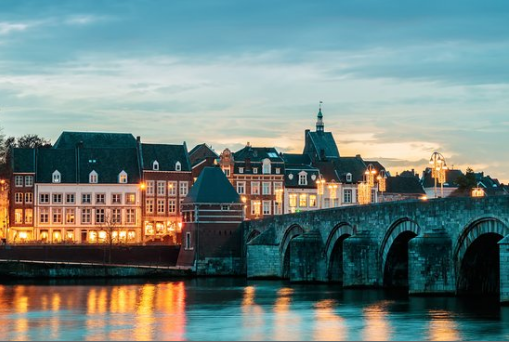
二、自然地理(地理环境、自然资源,交通情况)
Neighbourhoods
Maastricht consists of five districts (stadsdelen) and 44 neighbourhoods (wijken). Each neighbourhood has a number which corresponds to its postal code.
1, Maastricht Centrum (Binnenstad, Jekerkwartier, Kommelkwartier, Statenkwartier, Boschstraatkwartier, Sint Maartenspoort, Wyck-Céramique)
2, South-West (Villapark, Jekerdal, Biesland, Campagne, Wolder, Sint Pieter)
3, North-West (Brusselsepoort, Mariaberg, Belfort, Pottenberg, Malpertuis, Caberg, Malberg, Dousberg-Hazendans, Daalhof, Boschpoort, Bosscherveld, Frontenkwartier, Belvédère, Lanakerveld)
4, North-East (Beatrixhaven, Borgharen, Itteren, Meerssenhoven, Wyckerpoort, Wittevrouwenveld, Nazareth, Limmel, Amby)
5, South-East (Randwyck, Heugem, Heugemerveld, Scharn, Heer, De Heeg, Vroendaal)
The neighbourhoods of Itteren, Borgharen, Limmel, Amby, Heer, Heugem, Scharn, Oud-Caberg, Sint Pieter and Wolder all used to be separate municipalities or villages until they were annexed by the city of Maastricht in the course of the 20th century.

Typical street in the Jekerkwartier, part of the city centre
Neighbouring municipalities
The outlying areas of the following municipalities are bordering the municipality of Maastricht directly.
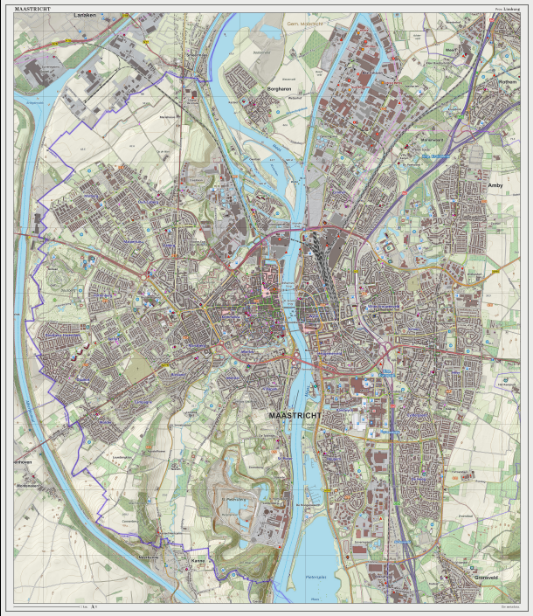
Dutch topographic map of Maastricht, March 2014
Border
Maastricht's city limits has an international border with Belgium. Most of it borders Belgium's Flemish region, but a small part to the south also has a border with the Walloon region. Both countries are part of Europe's Schengen Area thus are open without border controls.
Climate
Maastricht features the same climate as most of the Netherlands (Cfb, Oceanic climate), however, due to its more inland location in between hills, summers tend to be warmer (especially in the Meuse valley, which lies 70 metres lower than the meteorological station) and winters a bit colder, although the difference is only noticeable on just a few days a year. The highest temperature recorded was on 25 July 2019 at 39.6 °C (103.3 °F).
Transport
By car
Maastricht is served by the A2 and A79 motorways. The city can be reached from Brussels and Cologne in approximately one hour and from Amsterdam in about two and a half hours.
The A2 motorway runs through Maastricht in a double-decked tunnel. Before 2016, the A2 motorway ran through the city; heavily congested, it caused air pollution in the urban area. Construction of a two-level tunnel designed to solve these problems started in 2011 and was opened (in stages) by December 2016
In spite of several large underground car parks, parking in the city centre forms a major problem during weekends and bank holidays because of the large numbers of visitors. Parking fees are deliberately high to make visitors to use public transport or park and ride facilities away from the centre.
By train
Maastricht is served by three rail operators, all of which call at the main Maastricht railway station near the centre and two of which call at the smaller Maastricht Randwyck, near the business and university district. Only Arriva also calls at Maastricht Noord, which opened in 2013. Intercity trains northwards to Amsterdam, Eindhoven, Den Bosch and Utrecht are operated by Dutch Railways. The National Railway Company of Belgium runs south to Liège in Belgium. The line to Heerlen, Valkenburg and Kerkrade is operated by Arriva. The former railway to Aachen was closed down in the 1980s. A small section of the old westbound railway to Hasselt (Belgium) was restored in recent years and will be used as a modern tramline, scheduled to open in 2023.
By tram
The Dutch and Flanders governments reached an agreement in 2014 to build a new tram route, the Hasselt – Maastricht tramway, as part of the larger Spartacus scheme. It was scheduled to take three years, from 2015 to 2018, and to cost €283 million. However, the planning process has been heavily delayed, and as of 2018, construction has not yet started. The tram is now scheduled to be operating in 2024.When completed, the tram will carry passengers from Maastricht city centre to Hasselt city centre in 30 minutes. It will be operated by the Belgian transport company De Lijn, with 2 scheduled stops in Maastricht and another 10 in Flanders.
By bus
Regular bus lines connect the city centre, outer areas, business districts and railway stations. The regional Arriva bus network extends to most parts of South Limburg and Aachen in Germany. Regional buses by De Lijn connect Maastricht with Hasselt, Tongeren and Maasmechelen, and one bus connects Maastricht with Liège, operated by TEC.
By air
Maastricht is served by the nearby Maastricht Aachen Airport (IATA: MST, ICAO: EHBK), in nearby Beek, and it is informally referred to by that name. The airport is located about 10 kilometres (6 miles) north of the city centre. The airport is served by Corendon Dutch Airlines and Ryanair which operate scheduled flights to destinations around the Mediterranean, the Canary Islands and North-Africa . There are also charter flights to Lourdes which are operated by Enter Air.
By boat
Maastricht has a river port (Beatrixhaven) and is connected by water with Belgium and the rest of the Netherlands through the river Meuse, the Juliana Canal, the Albert Canal and the Zuid-Willemsvaart. Although there are no regular boat connections to other cities, various organized boat trips for tourists connect Maastricht with Belgium cities such as Liège.
三、经济发展和规模
In the industrial age production of ceramics, paper and glass dominated the economy of the city and still do to a certain extent. It continues to occupy a position at the heart of an important steel production/processing cluster but during the last decade has become a predominantly science and service centre. Today the most important economic activities are represented by the financial and business services industry, the education/health care sector, tourism and associated trade/hotel and catering industry (conference tourism). Some large companies have important facilities in or near Maastricht, such as Vodafone, DHL, Daimler, DSM (global science-based company active in health and nutrition) and SABIC (manufacture of chemicals, fertilisers and plastics).
The rich and well-preserved historical urban heritage exerts a powerful force of attraction with a total of 1,677 listed monuments and sites, second only to Amsterdam in the Netherlands. This in combination with organisation of cultural events, and popularity as a shopping and recreation pole means that Maastricht welcomes upwards of 1.5 million visitors annually, but in fact estimates show that many visitors come more than once (average 1.9 visits) which brings the real figure to 2.8 million.
In addition the city has developed strongly because of the presence and growth of the research based Maastricht University and the University of Applied Sciences (Hogeschool Zuyd) with a large and expanding international student population.
四、产业特点/重点项目
Sappi – South African Pulp and Paper Industry
Type: Public
Traded as JSE: SAP
OTC Pink: SPPJY
ISIN ZAE000006284
Founded 1936
Headquarters Johannesburg, South Africa
Key people
Sir Nigel Rudd (Chairman)
Stephen (Steve) Robert Binnie (CEO)
Glen Thomas Pearce (CFO)
Products paper, pulp
Revenue Increase US$5,296 million (2017)
Operating income
Decrease US$526 million (2017)
Net income
Increase US$338 million (2017)
Number of employees
12,800
Website www.sappi.com
BASF – previously Ten Horn; pigments
Type: Societas Europaea
Traded as FWB: BAS
DAX Component
ISIN: DE000BASF111
Industry; Chemicals
Founded: 6 April 1865; 155 years ago (as Badische Anilin und Soda Fabrik); Mannheim, Baden
Founder: Friedrich Engelhorn
Headquarters: Ludwigshafen, Germany
Key people:
Jürgen Hambrecht (Chairman of the supervisory board), Martin Brudermüller (CEO and Chairman of the executive board)
Products: Chemicals, plastics, performance chemicals, catalysts, coatings, crop technology, crude oil and natural gas exploration and production
Revenue: Decrease €59.316 billion (2019)
Operating income: Decrease €4.052 billion (2019)
Net income: Increase €8.421 billion (2019)
Total assets: Increase €86.950 billion (end 2019)
Total equity: Increase €42.350 billion (end 2019)
Number of employees: Decrease 117,628 (end 2019)
Website: basf.com
Oil and gas
BASF explores for and produces oil and gas through its subsidiary Wintershall Holding AG. In Central and Eastern Europe, Wintershall works with its Russian partner Gazprom.
Private companies based in Maastricht
Sappi – South African Pulp and Paper Industry
Royal Mosa – ceramic tiles
O-I Manufacturing;– previously Kristalunie Maastricht; glass
ENCI – cement factory
BASF – previously Ten Horn; pigments
Rubber Resources;– previously Radium Foam and Vredestein; rubber recycling
Hewlett-Packard – previously Indigo, manufacturer of electronic data systems
Vodafone – mobile phone company
Q-Park – international operator of parking garages
DHL – international express mail services
Teleperformance – contact center services
Mercedes-Benz – customer contact centre for Europe
VGZ – health insurance, customer contact centre
Pie Medical Imaging – cardiovascular quantitative analysis software
Esaote (former Pie Medical Equipment) – manufacturer of medical and veterinary diagnostic equipment
BioPartner Centre Maastricht – life sciences spin-off companies
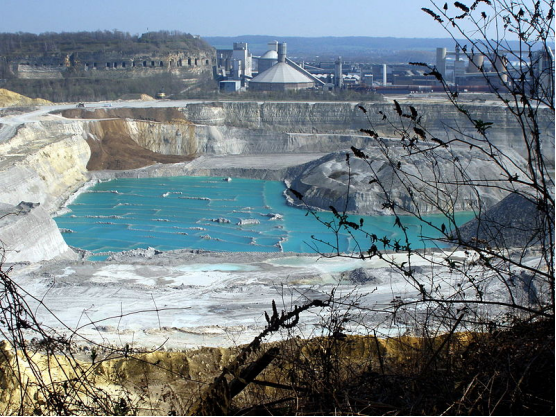
ENCI quarry
Office park Randwyck-Noord
Public institutions
Since the 1980s a number of European and international institutions have made Maastricht their base. They provide an increasing number of employment opportunities for expats living in the Maastricht area.
Administration of the Dutch province of Limburg
Meuse-Rhine Euroregion
Limburg Development Company LIOF
Rijksarchief Limburg – archives of the province of Limburg
Eurocontrol – The European Organisation for the Safety of Air Navigation
European Journalism Centre
European Institute of Public Administration (EIPA)
European Centre for Development Policy Management (ECDPM)
European centre for work and society (ECWS)
Maastricht Centre for Transatlantic Studies (MCTS)
Expert Centre for Sustainable Business and Development Cooperation (ECSAD)
Council of European Municipalities and Regions (REGR)
European Centre for Digital Communication (EC/DC)
UNU-MERIT
Maastricht Research School of Economics of TEchnology and ORganization (METEOR)
Research Institute for Knowledge Systems (RIKS)
Cicero Foundation (CF)
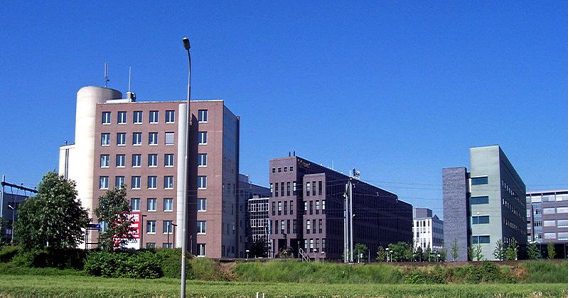
Provincial Government Buildings
五、风景名胜,景点
Maastricht is known in the Netherlands and beyond for its lively squares, narrow streets, and historic buildings. The city has 1,677 national heritage buildings (rijksmonumenten), more than any Dutch city outside Amsterdam. In addition to that there are 3,500 locally listed buildings (gemeentelijke monumenten). The entire city centre is a conservation area (beschermd stadsgezicht). The tourist information office (VVV) is located in the Dinghuis, a medieval courthouse overlooking Grote Staat. Maastricht's main sights include:
Meuse river, with several parks and promenades along the river, and some interesting bridges:
Sint Servaasbrug, partly from the 13th century; the oldest bridge in the Netherlands;
Hoge Brug ("High Bridge"), a modern pedestrian bridge designed by René Greisch;
City fortifications, including:
Remnants of the first and second medieval city wall and several towers (13th and 14th centuries);
Helpoort ("Hell's Gate"), an imposing gate with two towers, built shortly after 1230, the oldest city gate in the Netherlands;
Waterpoortje ("Little Water Gate"), a medieval gate in Wyck, used for accessing the city from the Meuse, demolished in the 19th century but rebuilt shortly afterwards;
Hoge Fronten (or: Linie van Du Moulin), remnants of 17th- and 18th-century fortifications with a number of well-preserved bastions and a nearby early 19th-century fortress, Fort Willem I;
Fort Sint-Pieter ("Fortress Saint Peter"), early 18th-century fortress on the flanks of Mount Saint Peter;
Casemates, an underground network of tunnels, built as sheltered emplacements for guns and cannons. These tunnels run for several kilometres underneath the city's fortifications, some isolated, others connected to each other. Guided tours are available.
Binnenstad: inner-city district with pedestrianized shopping streets including Grote and Kleine Staat, and high-end shopping streets Stokstraat and Maastrichter Smedenstraat. The main sights in Maastricht as well as a large number of cafés, pubs and restaurants are centred around the three main squares in Binnenstad:
A.Vrijthof, the largest and best-known square in Maastricht, with many well-known pubs and restaurants (including two - one former - gentlemen's clubs). Other sights include:
a.Basilica of Saint Servatius, a predominantly Romanesque church with important medieval sculptures (most notably the westwork and east choir sculpted capitals, corbels and reliefs, and the sculpted South Portal or Bergportaal). The tomb of Saint Servatius in the crypt is a favoured place of pilgrimage. The church has an important church treasury;
b.Sint-Janskerk, a Gothic church dedicated to Saint John the Baptist, the city's main Protestant church since 1632, adjacent to the Basilica of Saint Servatius, with a distinctive red, limestone tower;
C. Spaans Gouvernement ("Spanish Government Building"), a 16th-century former canon's house, also used by the Brabant and Habsburg rulers, now housing the Museum aan het Vrijthof;
d. Hoofdwacht ("Main Watch"), a 17th-century military guard house, used for exhibitions;
e. Generaalshuis ("General's House"), a Neoclassical mansion, now the city's main theater (Theater aan het Vrijthof).
B. Onze Lieve Vrouweplein, a tree-lined square with a number of pavement cafes. Main sights:
a. Basilica of Our Lady, an 11th-century church, one of the Netherlands' most significant Romanesque buildings with an important church treasury. Perhaps best known for the shrine of Our Lady, Star of the Sea in an adjacent Gothic chapel;
b. Derlon Museumkelder, a small museum with Roman and earlier remains in the basement of Hotel Derlon.
C. Markt, the town's market square, completely refurbished in 2006-07 and now virtually traffic free. Sights include:
a. The Town Hall, built in the 17th century by Pieter Post and considered one of the highlights of Dutch Baroque architecture. Nearby is Dinghuis, the medieval town hall and courthouse with an early Renaissance façade;
b. Mosae Forum, a new shopping centre and civic building designed by Jo Coenen and Bruno Albert. Inside the Mosae Forum parking garage is a small exhibition of Citroën miniature cars;
c. Entre Deux, a rebuilt shopping centre in Postmodern style, which has won several international awards. It includes a bookstore located inside a former 13th-century Dominican church. In 2008, British newspaper The Guardian proclaimed this the world's most beautiful bookshop.[31]
Jekerkwartier, a neighbourhood named after the small river Jeker, which pops up between old houses and remnants of city walls. The western part of the neighbourhood (also called the Latin Quarter of Maastricht), is dominated by university buildings and art schools. Sights include:
A.a number of churches and monasteries, some from the Gothic period (the Old Franciscan Church), some from the Renaissance (Faliezustersklooster), some from the Baroque period (Bonnefanten Monastery; Walloon Church, Lutheran Church);
B.Maastricht Natural History Museum, a small museum of natural history in a former monastery;
C.Grote Looiersstraat ("Great Tanners' Street"), a former canal that was filled in during the 19th century, lined with elegant houses, the city's poorhouse (now part of the university library) and Sint-Maartenshofje, a typically Dutch hofje.
Kommelkwartier and Statenkwartier, two relatively quiet inner city neighbourhoods with several imposing monasteries and university buildings. The largely Gothic Crosier Monastery is now a five-star hotel.
Boschstraatkwartier, an upcoming neighbourhood and cultural hotspot in the north of the city centre. Several of the former industrial buildings are being transformed for new uses.
A.Sint-Matthiaskerk, a 14th-century parish church dedicated to Saint Matthew;
B.Bassin, a restored early 19th-century inner harbor with restaurants and cafés on one side and interesting industrial architecture on the other side.
Wyck, the old quarter on the right bank of the river Meuse.
A.Saint Martin's Church, a Gothic Revival church designed by Pierre Cuypers in 1856;
B.Rechtstraat is a street in Wyck, with many historic buildings and a mix of specialty shops, art galleries and restaurants;
C.Stationsstraat and Wycker Brugstraat are elegant streets with the majority of the buildings dating from the late 19th century. At the east end of Stationsstraat stands the Maastricht railway station from 1913.
Céramique, a modern neighbourhood on the site of the former Céramique potteries with a park along the river Meuse (Charles Eyckpark). Now a showcase of architectural highlights:
A.Wiebengahal, one of the few remaining industrial monuments in the neighbourhood and an early example of modern architecture in the Netherlands, dating from 1912;
B.Bonnefanten Museum by Aldo Rossi;
C.Centre Céramique, a public library and exhibition space by Jo Coenen;
D.La Fortezza, an office and apartment building by Mario Botta;
E.Siza Tower, a residential tower clad with zinc and white marble, by Álvaro Siza Vieira;
F.Also buildings by MBM, Cruz y Ortiz, Luigi Snozzi, Aurelio Galfetti, Herman Hertzberger, Wiel Arets, Hubert-Jan Henket, Charles Vandenhove and Bob Van Reeth.
Sint-Pietersberg ("Mount Saint Peter"): modest hill and nature reserve south of the city, peaking at 171 metres (561 ft) above sea level. It serves as Maastricht's main recreation area and a viewing point. The main sights include:
A.Fort Sint-Pieter, an early 18th-century military fortress fully restored in recent years;
Caves of Maastricht aka Grotten Sint-Pietersberg, an underground network of man-made tunnels ("caves") in limestone quarries. Guided tours are available;
B.Slavante, a country pavilion and restaurant on the site of a Franciscan monastery of which parts remain;
C.Lichtenberg, a ruined medieval castle keep and a small museum in an adjacent farmstead;
D.D'n Observant ("The Observer"), an artificial hilltop, made with the spoils of a nearby quarry, now a nature reserve.
Museums in Maastricht
A.Bonnefanten Museum is the foremost museum for old masters and contemporary fine art in the province of Limburg. The collection features medieval sculpture, early Italian painting, Southern Netherlandish painting, and contemporary art.
B.The Treasury of the Basilica of Saint Servatius includes religious artifacts from the 4th to 20th centuries, notably those related to Saint Servatius. Highlights include the shrine, the key and the crosier of Saint Servatius, and the reliquary bust donated by Alexander Farnese, Duke of Parma.
C.The Treasury of the Basilica of Our Lady contains religious art, textiles, reliquaries, liturgical vessels and other artifacts from the Middle Ages and later periods.
D.Derlon Museumkelder is a preserved archeological site in the basement of a hotel with Roman and pre-Roman remains.
E.The Maastricht Natural History Museum exhibits collections relating to the geology, paleontology and flora and fauna of Limburg. Highlights in the collection are several fragment of skeletons of Mosasaurs found in a quarry in Mount Saint Peter.
F.Museum aan het Vrijthof is a local art and history museum based in the 16th-century Spanish Government building, featuring some period rooms with 17th- and 18th-century furniture, clocks, Maastricht silver, porcelain, glassware and Maastricht pistols, and temporary exhibitions of local artists and designers.
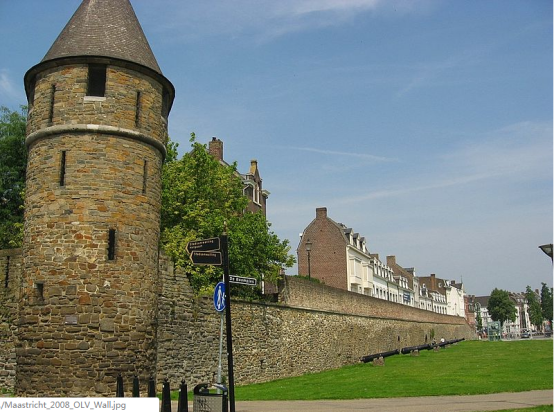
Medieval city wall (Onze-Lieve-Vrouwewal)
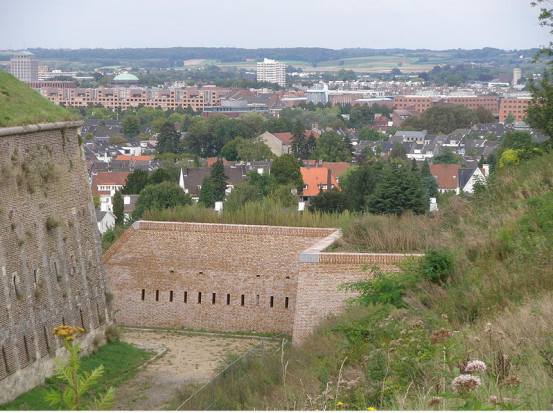
View of Maastricht from the fortress on Mount Saint Peter
Parks
There are several city parks and recreational areas in Maastricht:
A.Stadspark, the main public park in Maastricht, partly 19th-century, with remnants of the medieval city walls, a branch of the Jeker river, a mini-zoo and several public sculptures (e.g. the statue of d'Artagnan in Aldenhofpark, a 20th-century extension of Stadspark). Other extensions of the park are called Kempland, Henri Hermanspark, Monseigneur Nolenspark and Waldeckpark. From 2014 onwards, the grounds of the former Tapijn military barracks will be gradually added to the park;
B.Jekerpark, a new park along the river Jeker, separated from Stadspark by a busy road;
C.Frontenpark, a new park west of the city centre, incorporating parts of the fortifications of Maastricht from the 17th to 19th centuries;
D.Charles Eykpark, a modern park between the public library and Bonnefanten Museum on the east bank of the Meuse river, designed in the late 1990s by Swedish landscape architect Gunnar Martinsson.
E.Griendpark, a modern park on the east bank of the river with an inline-skating and skateboarding course.
F.Geusseltpark in eastern Maastricht and J.J. van de Vennepark in western Maastricht, both with elaborate sports facilities.
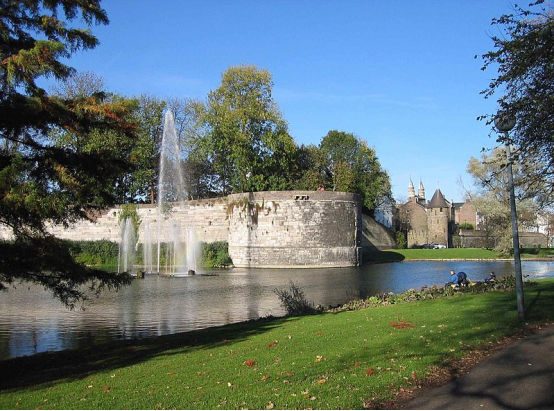
A pond in Stadspark, Maastricht's main park
六、历史文化
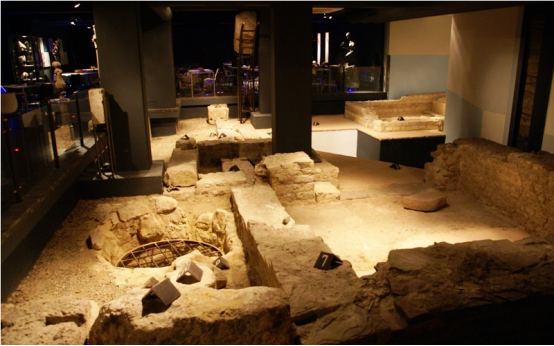
Maastricht is mentioned in ancient documents as Treiectinsem ab. 575, Treiectensis in 634, Triecto, Triectu in 7th century, Triiect in 768–781, Traiecto in 945, Masetrieth in 1051.
The place name Maastricht is an Old Dutch compound Masa- (> Maas "the Meuse river") + Old Dutch *treiekt, itself borrowed from Gallo-Romance *TRA(I)ECTU cf. its Walloon name li trek, from Classical Latin trajectus ("ford , passage, place to cross a river") with the later addition of Maas "Meuse" to avoid the confusion with the -trecht of Utrecht having exactly the same original form and etymology. The Latin name first appears in medieval documents and it is not known whether *Trajectu(s) was Maastricht's name during Roman times. A resident of Maastricht is referred to as Maastrichtenaar whilst in the local dialect it is either Mestreechteneer or, colloquially, Sjeng (derived from the formerly popular French name Jean).
Early history
Neanderthal remains have been found to the west of Maastricht (Belvédère excavations). Of a later date are Palaeolithic remains, between 8,000 and 25,000 years old. Celts lived here around 500 BC, at a spot where the river Meuse was shallow and therefore easy to cross.
It is not known when the Romans arrived in Maastricht, or whether the settlement was founded by them. The Romans built a bridge across the Meuse in the 1st century AD, during the reign of Augustus Caesar. The bridge was an important link in the main road between Bavay and Cologne. Roman Maastricht was probably relatively small. Remains of the Roman road, the bridge, a religious shrine, a Roman bath, a granary, some houses and the 4th-century castrum walls and gates, have been excavated. Fragments of provincial Roman sculptures, as well as coins, jewellery, glass, pottery and other objects from Roman Maastricht are on display in the exhibition space of the city's public library (Centre Céramique).
According to legend, the Armenian-born Saint Servatius, Bishop of Tongeren, died in Maastricht in 384 where he was interred along the Roman road, outside the castrum. According to Gregory of Tours bishop Monulph was to have built around 570 the first stone church on the grave of Servatius, the present-day Basilica of Saint Servatius. The city remained an early Christian diocese until it lost the distinction to nearby Liège in the 8th or 9th century.
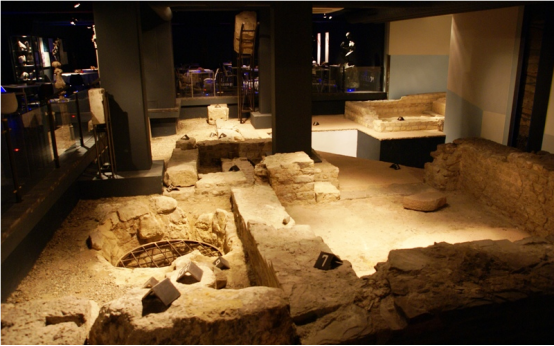
Roman sanctuary in the basement of Hotel Derlon
Middle Ages
The 12th-century Keizerzaal or Emperor's Hall in the westwork of the Basilica of Saint Servatius
In the early Middle Ages Maastricht was part of the heartland of the Carolingian Empire along with Aachen and the area around Liège. The town was an important centre for trade and manufacturing. Merovingian coins minted in Maastricht have been found in places throughout Europe. In 881 the town was plundered by the Vikings. In the 10th century it briefly became the capital of the duchy of Lower Lorraine.
During the 12th century the town flourished culturally. The provosts of the church of Saint Servatius held important positions in the Holy Roman Empire during this era. The two collegiate churches were largely rebuilt and redecorated. Maastricht Romanesque stone sculpture and silversmithing are regarded as highlights of Mosan art. Maastricht painters were praised by Wolfram von Eschenbach in his Parzival. Around the same time, the poet Henric van Veldeke wrote a legend of Saint Servatius, one of the earliest works in Dutch literature. The two main churches acquired a wealth of relics and the septennial Maastricht Pilgrimage became a major event.
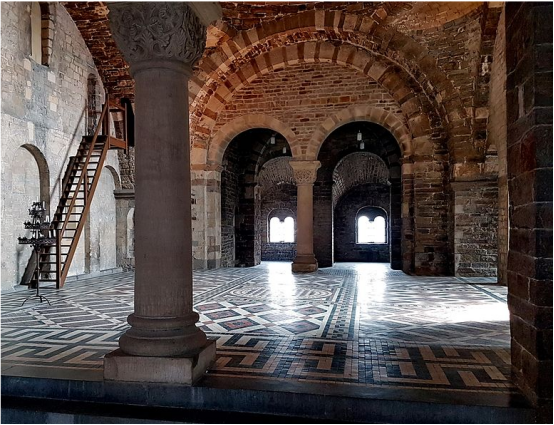
The 12th-century Keizerzaal or Emperor's Hall in the westwork of the Basilica of Saint Servatius
Unlike most Dutch towns, Maastricht did not receive city rights at a certain date. These developed gradually during its long history. In 1204 the city's dual authority was formalised in a treaty, with the prince-bishops of Liège and the dukes of Brabant holding joint sovereignty over the city. Soon afterwards the first ring of medieval walls were built. In 1275, the old Roman bridge collapsed under the weight of a procession, killing 400 people. A replacement, funded by church indulgences, was built slightly to the north and survives until today, the Sint Servaasbrug.
Throughout the Middle Ages, the city remained a centre for trade and manufacturing principally of wool and leather but gradually economic decline set in. After a brief period of economic prosperity around 1500, the city's economy suffered during the wars of religion of the 16th and 17th centuries, and recovery did not happen until the industrial revolution in the early 19th century.
16th to 18th centuries
The Siege of Maastricht (1579) as depicted in the Palace of Aranjuez
The important strategic location of Maastricht resulted in the construction of an impressive array of fortifications around the city during this period. The Spanish and Dutch garrisons became an important factor in the city's economy. In 1579 the city was sacked by the Spanish army led by the Duke of Parma (Siege of Maastricht, 1579). For over fifty years the Spanish crown took over the role previously held by the dukes of Brabant in the joint sovereignty over Maastricht. In 1632 the city was conquered by Prince Frederick Henry of Orange and the Dutch States General replaced the Spanish crown in the joint government of Maastricht.
Another Siege of Maastricht (1673) took place during the Franco-Dutch War. In June 1673, Louis XIV laid siege to the city because French supply lines were being threatened. During this siege, Vauban, the famous French military engineer, developed a new tactic in order to break down the strong fortifications surrounding Maastricht. His systematic approach remained the standard method of attacking fortresses until the 20th century. On 25 June 1673, while preparing to storm the city, captain-lieutenant Charles de Batz de Castelmore, also known as the comte d'Artagnan, was killed by a musket shot outside the Tongerse Poort. This event was embellished in Alexandre Dumas' novel The Vicomte de Bragelonne, part of the D'Artagnan Romances. French troops occupied Maastricht from 1673 to 1678.
In 1748 the French again conquered the city at what is known as the Second French Siege of Maastricht, during the War of Austrian Succession. The French took the city for the last time in 1794, when the condominium was dissolved and Maastricht was annexed to the First French Empire (1794–1814). For twenty years Maastricht remained the capital of the French département of Meuse-Inférieure.
19th and early 20th century
19th-century industry: Maastricht potteries in Boschstraat
After the Napoleonic era, Maastricht became part of the United Kingdom of the Netherlands in 1815. It was made the capital of the newly formed Province of Limburg (1815–1839). When the southern provinces of the newly formed kingdom seceded in 1830, the Dutch garrison in Maastricht remained loyal to the Dutch king, William I, even when most of the inhabitants of the town and the surrounding area sided with the Belgian revolutionaries. In 1831, arbitration by the Great Powers allocated the city to the Netherlands. However, neither the Dutch nor the Belgians agreed to this and the arrangement was not implemented until the 1839 Treaty of London. During this period of isolation Maastricht developed into an early industrial town.
Plate commemorating the liberation, 14 Sept. 1944
Because of its eccentric location in the southeastern Netherlands, and its geographical and cultural proximity to Belgium and Germany, integration of Maastricht and Limburg into the Netherlands did not come about easily. Maastricht retained a distinctly non-Dutch appearance during much of the 19th century and it was not until the First World War that the city was forced to look northwards.
Like the rest of the Netherlands, Maastricht remained neutral during World War I. However, being wedged between Germany and Belgium, it received large numbers of refugees, putting a strain on the city's resources. Early in World War II, the city was taken by the Germans by surprise during the Battle of Maastricht of May 1940. On 13 and 14 September 1944 it was the first Dutch city to be liberated by Allied forces of the US Old Hickory Division. The three Meuse bridges were destroyed or severely damaged during the war. As elsewhere in the Netherlands, the majority of Maastricht Jews died in Nazi concentration camps.
After World War II
Prime minister Dries van Agt presiding over the 1981 European Council in the town hall
During the latter half of the century, traditional industries (such as Maastricht's potteries) declined and the city's economy shifted to a service economy. Maastricht University was founded in 1976. Several European institutions found their base in Maastricht. In 1981 and 1991 European Councils were held in Maastricht, the latter one resulting a year later in the signing of the Maastricht Treaty, leading to the creation of the European Union and the euro. Since 1988, The European Fine Art Fair, regarded as the world's leading art fair, annually draws in some of the wealthiest art collectors.
In recent years, Maastricht launched several campaigns against drug-dealing in an attempt to stop foreign buyers taking advantage of the liberal Dutch legislation and causing trouble in the downtown area.
Since the 1990s, large parts of the city have been refurbished, including the areas around the main railway station and the Maasboulevard promenade along the Meuse, the Entre Deux and Mosae Forum shopping centres, as well as some of the main shopping streets. A prestigious quarter designed by international architects and including the new Bonnefanten Museum, a public library, and a theatre was built on the grounds of the former Société Céramique factory near the town centre. Further large-scale projects, such as the redevelopment of the area around the A2 motorway, the Sphinx Quarter and the Belvédère area are under construction.
七、其他信息
Maastricht is located on both sides of the Meuse (Dutch: Maas), at the point where the Jeker joins it. It became well known through the Maastricht Treaty and as the birthplace of the euro. Maastricht has 1677 national heritage buildings (Rijksmonumenten), the second highest number in the Netherlands, after Amsterdam.
Maastricht, a university city on the southern tip of the Netherlands, is distinguished by its medieval-era architecture and vibrant cultural scene.
Jewish inhabitants of Maastricht
Maastricht Treaty
Treaty of Maastricht (1843)
The Maastrichtian Age, which marks the end of the Cretaceous Period and Mesozoic Era of geological time
八、联系方式
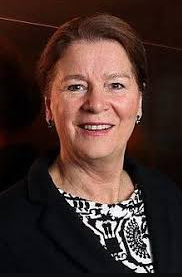
Mayor Annemarie Penn-te Strake (independent)
Personal details
Born Johanna Maria Penn-te Strake
31 July 1953 (age 66)
Helmond, Netherlands
Nationality Dutch
Residence Maastricht, Netherlands
Occupation Politician
Government
Body Municipal council
Postcode: 6200–6229
City Hall: Maastricht City Hall
Visiting address:
Gemeente Maastricht, Mosae Forum 10, 6211 DW Maastricht
Postal address
Gemeente Maastricht, Postbus 1992, 6201 BZ Maastricht
E-mail, internet and telephone
E-mail: post@maastricht.nl
Telephone:
To talk to a municipal official: 14 043 or 0031 43 350 40 40.
Internet: www.gemeentemaastricht.nl
http://www.gemeentemaastricht.nl/english/
